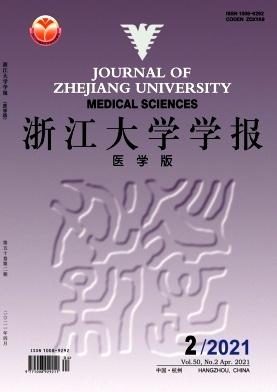Analysis of genotypes and biochemical phenotypes of neonates with abnormal metabolism of butyrylcarnitine
Q2 Medicine
Zhejiang da xue xue bao. Yi xue ban = Journal of Zhejiang University. Medical sciences
Pub Date : 2023-12-01
DOI:10.3724/zdxbyxb-2023-0459
引用次数: 0
Abstract
[ Abstract ] Objective : To investigate the genotypes and biochemical phenotypes of neonates with abnormal metabolism of butyrylcarnitine (C4). Methods : One hundred and twenty neonates with increased C4 levels detected by tandem mass spectrometry in the neonatal screening at Children ’ s Hospital of Zhejiang University School of Medicine from January 2018 to June 2023. The initial screening data and recalled data of C4 and C4/C3 were collected and converted into multiples of C4 reference range. The next generation sequencing was performed and the exons with adjacent 50 bp regions of ACAD8 and ACADS genes were captured by liquid phase capture technique. The variants were obtained by bioinformatic analysis and the pathogenicity were classified according to the ACMG criteria. The neonates with increased C4 levels were divided into ACAD8 biallelic variants group, ACADS biallelic variants group and ACADS monoallelic variants group. The Wilcoxon rank sum test was used to analyze the differences among the groups. Results : In total, 32 variants in ACAD8 gene were detected, of which 7 variants were first discovered; while 41 variants of ACADS gene were detected, of which 17 variants had not been reported yet. There were 39 cases with ACAD8 biallelic variants, 3 cases with ACAD8 monoallelic variants; 34 cases with ACADS biallelic variants and 36 cases with ACADS monoallelic variants. Furthermore, 5 cases were detected with both ACAD8 and ACADS gene variants. Inter group comparison showed that the multiples of C4 reference range in initial screening and reexamination of the ACAD8 biallelic variants and ACADS biallelic variants groups were significantly higher than those of the ACADS monoallelic variants group (all P <0.01), while the multiples in the ACAD8 biallelic variants group were significantly higher than those in the ACADS biallelic variants group (all P <0.01). The multiples of C4 reference range in initial screening greater than 1.5 times were observed in all neonates carrying ACAD8 or ACADS biallelic variants, while only 25.0 % (9/36) in neonates carrying ACADS monoallelic variants. Conclusion : ACAD8 and/or ACADS gene variants are the main genetic causes of elevated C4 in newborns in Zhejiang region with high genotypic heterogeneity. The C4 levels of neonates with biallelic variants are significantly higher than those of neonates with monoallelic variants. If the cutoff value of C4 level could be modestly elevated, false positive rate would be reduced in tandem mass spectrometry neonatal screening.丁酰肉碱代谢异常新生儿的基因型和生化表型分析
【摘要】目的:探讨丁基肉碱(C4)代谢异常新生儿的基因型和生化表型。方法:2018年1月至2023年6月浙江大学医学院附属儿童医院新生儿筛查中,采用串联质谱法检测到120例C4水平增高的新生儿。收集C4和C4/C3的初始筛选数据和召回数据,并将其转换为C4参考范围的倍数。进行下一代测序,采用液相捕获技术捕获ACAD8和ACADS基因相邻50 bp区域的外显子。通过生物信息学分析获得变异,并根据ACMG标准进行致病性分类。将C4水平升高的新生儿分为ACAD8双等位基因变异组、ACADS双等位基因变异组和ACADS单等位基因变异组。采用Wilcoxon秩和检验分析组间差异。结果:共检测到32个ACAD8基因变异,其中7个为首次发现;检测到41个ACADS基因变异,其中17个未报道。ACAD8双等位基因变异39例,单等位基因变异3例;ACADS双等位变异34例,单等位变异36例。5例同时携带ACAD8和ACADS基因变异。组间比较显示,ACAD8双等位变异组和ACADS双等位变异组初筛和复检C4参考范围的倍数显著高于ACADS单等位变异组(均P <0.01),而ACAD8双等位变异组的倍数显著高于ACADS双等位变异组(均P <0.01)。所有携带ACAD8或ACADS双等位基因变异的新生儿初始筛查时C4参考范围的倍数大于1.5倍,而携带ACADS单等位基因变异的新生儿只有25.0%(9/36)。结论:ACAD8和/或ACADS基因变异是浙江地区新生儿C4升高的主要遗传原因,且具有较高的基因型异质性。双等位基因变异新生儿C4水平显著高于单等位基因变异新生儿。若能适度提高C4水平的临界值,则可降低串联质谱新生儿筛查的假阳性率。
本文章由计算机程序翻译,如有差异,请以英文原文为准。
求助全文
约1分钟内获得全文
求助全文
来源期刊

Zhejiang da xue xue bao. Yi xue ban = Journal of Zhejiang University. Medical sciences
Medicine-Medicine (all)
CiteScore
3.80
自引率
0.00%
发文量
67
 求助内容:
求助内容: 应助结果提醒方式:
应助结果提醒方式:


